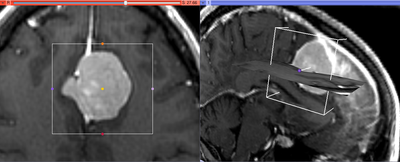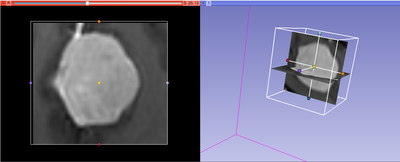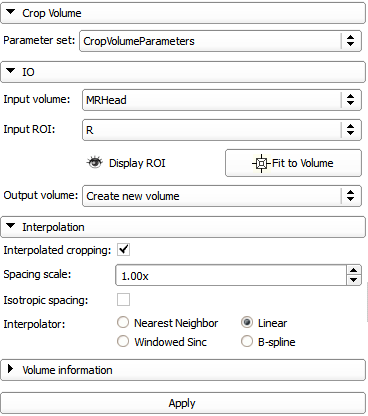Home < Documentation < Nightly < Modules < CropVolume
Introduction and Acknowledgements
|
This work is part of the National Alliance for Medical Image Computing (NA-MIC), funded by the National Institutes of Health through the NIH Roadmap for Medical Research, Grant U54 EB005149. Information on NA-MIC can be obtained from the NA-MIC website. The development of this module was supported in part by NIH CA111288 and CA151261.
Author: Andrey Fedorov, Ron Kikinis, SPL
Contact: Andrey Fedorov, <email>fedorov@bwh.harvard.edu</email>
|
|
|
Module Description
This module allows to extract rectangular subvolume from a scalar image, with the subvolume defined by Slicer ROI widget.
You can use this module to crop a DTI or DWI volume.
The cropping functionality of this module is enabled by Resample Scalar/Vector/DWI Volume module, which is called internally.
Use Cases
|
Most frequently used for these scenarios:
- You are trying to segment an object that occupies small portion of the image. Cropping the ROI with that object can simplify your segmentation task and reduce both the memory requirements and processing time.
- You are trying to segment an image that has very different resolution along different axes (for example, 0.2mm with in an image slice, 1.0mm between slices). Isotropic spacing option ensures that the output volume has equal spacing on all axes. Doing this as part of cropping is useful, because forcing the same (high) resolution in all axes would increase the total number of voxels (and therefore memory need, processing times, etc.), but removing irrelevant parts of the volume can compensate for this increase in size.
- You are trying to register two objects that occupy smaller portions of the image. In this scenario, cropping will allow you to focus the processing at the region of interest, and simplify registration initialization.
- Define new axis directions for your image: Interpolated cropping option allows the output volume to have different axis directions that the original volume. The output volume's axis directions will be aligned with the ROI widget's axes. ROI widget axes can be rotated using Transforms module.
|
|
Tutorials
Not available at this time, but see the list of Slicer 3.6 tutorials that use CropVolume here: Modules:CropVolume-Documentation-3.6.
Panels and their use
- Crop Volume panel: contains a selector to save/retrieve cropping presets.
- IO panel:
- Input volume defines the input image from which you need to crop a subvolume. Input volume can be under a transform.
- Input ROI is a Region of Interest (see the ROI module documentation), which can be defined outside CropVolume, or by creating new ROI by using the Mouse Interaction toolbar (selection ROI mode and clicking on two points in a slice or 3D view). The ROI can be adjusted using the widget handles in slice and 3D views. ROI can be rotated/translated using a transform.
- ROI visibility allows to turn the visibility of the 3D widget on or off in the 3D view panel.
- Fit to VOlume adjusts the ROI to be aligned with the input volume, including axis directions. To crop a volume using axes aligned to RAS, place the ROI using the Mouse interaction toolbar.
- Output volume defines the volume node where the cropped output will be written into. By default, if no node is selected, output volume is created automatically.
- Interpolation
- Interpolated cropping will resample the content of the image within the ROI given the interpolation options explained below. If disabled, then only the extent of the volume is changed but spacing and axes directions remain exactly the same.
- Interpolation options
- Spacing scale is the coefficient used to determine the spacing of the output volume. The output spacing is defined by multiplying the input spacing in each dimension by the user-specified coefficient. For example, if the input spacing is 1x1x1.4, and the scaling coefficient is 0.5, the output volume will have spacing 0.5x0.5x0.7, effectively doubling the resolution of the output image.
- Isotropic spacing if this checkbox is selected, the output image will have isotropic spacing, with the voxel size of the output image in each dimension equal to the smallest voxel dimension of the input image multiplied by the scaling constant.
- Interpolator allows to select between Nearest Neighbor, Linear, Windowed Sinc or B-spline interpolators (see Resample Scalar/Vector/DWI Volume for details). For subvolumes being extracted from a label volume, you should use Nearest Neighbor interpolator. Otherwise B-spline is the preferred choice. Linear interpolator requires less computation, which may be important for very large ROIs.
- Volume information shows preview of spacing and dimensions of the cropped output volume and, for comparison, the input volume. Average dimensions of a volume is about 200-300 voxels along each axis. If the resolution is increased using Spacing scale and Isotropic spacing then it is recommended to reduce the region of interest so that the dimensions are not increased significantly.
- Apply button initiates the subvolume extraction based on the inputs and parameters.
|
|
Cropping of oblique sub-volumes can be done by placing either or both of input volume and ROI under transform(s). These transforms will be taken into account while preparing the output.
Similar Modules
References
N/A
Information for Developers





